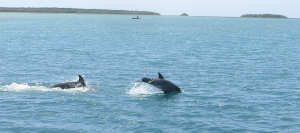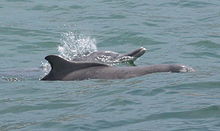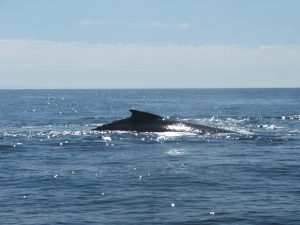On boat tours in the vicinity of Wasini Island, we can spot three species of marine mammals:
1. Bottlenose dolphin
2. Humpback dolphin
3. Humpback whale (seasonal)
Bottlenose dolphins
Bottlenose dolphins, the genus Tursiops, are the most common and well-known members of the family Delphinidae, the family of oceanic dolphin. Recent molecular studies show the genus contains two species, the common bottlenose dolphin (Tursiops truncatus) and the Indo-Pacific bottlenose dolphin (Tursiops aduncus), instead of one. Research in 2011 revealed a third species, the Burrunan dolphin (Tursiops australis). Bottlenose dolphins inhabit warm and temperate seas worldwide.

Bottlenose dolphins live in groups typically of 10–30 members, called pods, but group size varies from single individuals up to more than 1,000. Their diets consist mainly of forage fish. Dolphins often work as a team to harvest fish schools, but they also hunt individually. Dolphins search for prey primarily using echolocation, which is similar to sonar. They emit clicking sounds and listen for the return echos to determine the location and shape of nearby items, including potential prey. Bottlenose dolphins also use sound for communication, including squeaks and whistles emitted from the blowhole and sounds emitted through body language, such as leaping from the water and slapping their tails on the water surface.
Conservation -> bottlenose dolphins are not endangered. Their future is stable because of their abundance and adaptability. However, specific populations are threatened due to various environmental changes.
Humpback dolphins
Humpback dolphins are members of the genus Sousa. These dolphins are characterized by the conspicuous humps and elongated dorsal fins found on the backs of adults of the species. They are found close to shore along the coast of West Africa (Atlantic species/variety) and right along the coast of the Indian Ocean from South Africa to Australia (Indo-Pacific species/varieties).

The dorsal fin of the humpback dolphin is to some degree falcate. The pectoral fins are considerably small and the tail flukes have a well-defined median notch. On each side of the jaw there are 30 to 34 small coned-shaped teeth. Newborn calves are a cream or pearl shade of white, much like that of an adult beluga whale, whereas the adults have a more dull off-white coloring from the tail to the snout. Their flanks are somewhat of a dark grey, and their stomachs are a lighter shade of grey. Adults can reach from 1.8 to 2.6 metres (5 ft 11 in to 8 ft 6 in) and weigh in the range of 100 to 139 kilograms (220 to 310 lb).
Conservation -> the species is listed in the Convention on the Conservation of Migratory Species of Wild Animals (CMS) and has been categorized as being in danger of extinction throughout all or a significant proportion of its range and CMS Parties strive towards strictly protecting these animals, conserving or restoring the places where they live, mitigating obstacles to migration and controlling other factors that might endanger them.
Humpback whales
The humpback whale (Megaptera novaeangliae) is a species of baleen whale. One of the larger rorqual species, adults range in length from 12–16 metres (39–52 ft) and weigh approximately 36,000 kilograms (79,000 lb). The humpback has a distinctive body shape, with unusually long pectoral fins and a knobbly head. It is an acrobatic animal known for breaching and slapping the water with its tail and pectorals.
Males produce a complex song lasting 10 to 20 minutes, which they repeat for hours at a time. Its purpose is not clear, though it may have a role in mating.

Found in oceans and seas around the world, humpback whales typically migrate up to 25,000 kilometres (16,000 mi) each year. Humpbacks feed only in summer, in polar waters, and migrate to tropical or subtropical waters to breed and give birth in the winter. During the winter, humpbacks fast and live off their fat reserves. Their diet consists mostly of krill and small fish. Humpbacks have a diverse repertoire of feeding methods, including the bubble net feeding technique.
Conservation -> like other large whales, the humpback was and is a target for the whaling industry. Once hunted to the brink of extinction, its population fell by an estimated 90% before a moratorium was introduced in 1966. While stocks have since partially recovered, entanglement in fishing gear, collisions with ships, and noise pollution continue to impact the 80,000 humpbacks worldwide.
Threats for Local Marine Mammals:
Entanglements in fishing nets/lines, by-catch, vessel strikes and activity, habitat degradation (caused by a number of human activities), depletion of fish stocks through fishery industry, pollution, climate change.
